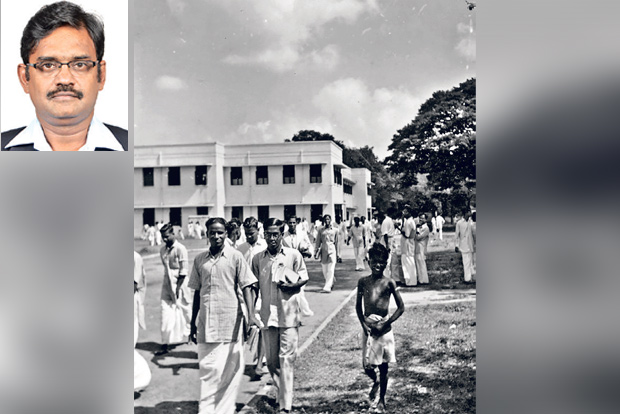Begin typing your search...
Alma mater of Ramanujan and Annadurai, Pachaiyappa’s ‘baptised’ many a luminary
In this series, we take a trip down memory lane, back to the Madras of the 1900s, as we unravel tales and secrets of the city through its most iconic personalities and episodes

Chennai
Around 1770, a young orphan from Periyapalayam moved to the city of the British Madras, which had just fended off the besieging French. Under a mentor who was a free merchant, he learnt their overlord’s language and while millions of his countrymen remained profoundly ignorant of modes of approaching their colonial masters, Pachaiyappa learnt English, French and at 16 became a Dubash (dho bash — two languages). He ventured to interpret the foreign words of each other and soon by age of 21 settled to a very comfortable business and made millions.
Pachaiyappa Mudaliar even lent Rs one lakh to the Serfoji of Thanjavur and like the kings of yore, he became a philanthropist. Pachaiyappa rebuilt the dilapidated east gopuram of the famed Chidambaram temple. Awed by his demi royal status, Ramanuja Kavirayar (who was the guru of George Uglow Pope) wrote a Pancharatnamala on Pachaiyappa Mudaliar.
However, despite having two wives, Pachaiyappa left no blood heirs. But before his death, he executed a will for his immense assets — perhaps the first will by an Indian. Mudaliar had willed that his wealth be utilised for temple charities and reconstruction. But Pachaiyappa’s benevolent nature was not inherited by men who had control over his assets. And perhaps because it was the first will, its contents weren’t respected by subsequent heirs who used its novelty to interpret it according to their wishes. His wives fought over the will and so did several successive people.
George Norton, the attorney general of Madras Presidency, hearing of the legal tussles to misappropriate Pachaiyappa’s properties wanted to create a permanent safety net for the cash, government bonds and jewellery, worth around Rs six lakh. Norton construed that the testament of Pachaiyappa also had provisions to be used to run educational institutions. On an application by Norton, the Supreme Court of Madras allowed a decree in 1841, directing that the surplus money left after fulfilment of religious bequests ought to be utilised for establishing educational institutions in the Presidency.
Madras was known for its early educational institutions but most were missionary or government-aided. The first college not to be aided by them was Pachaiyappa’s Central Institution. The Broadway building was designed like the Temple of Theseus in Athens in 1842 and started as a preparatory school. It was recognised as a college in 1889, and an unknown lawyer from South Africa MK Gandhi gave his first speech in Madras in this building. Notably, only Hindu students were admitted in Pachaiyappa’s institutions for a century.
Over the turn of the century, the swelling student populace and the crowds at Broadway made the trustees seek a more commodious space. Hostels were built on the greeny patch in Chetpet. In 1933, conducting a raffle for Rs 50,000 and along with an additional government grant, Pachaiyappa’s College finally moved to a 43-acre plot along the Poonamallee High Road. The new college structures were inaugurated in 1940, by Sir Arthur Hope, Governor of Madras.
The college’s alumni have risen to great heights (like mathematical genius Srinivasa Ramanujan) and once in the late 1960s, it was noted that the chief ministers of adjoining states, Andhra Pradesh and Tamil Nadu, had studied here. CN Annadurai, who studied on a poverty scholarship at the college and went on to become the general secretary of the college Students Union in 1931, would fondly remember his teachers at Pachaiyappa’s. English oration, a love for Tamil and initial knowledge on social justice, he would say, were imparted by his teachers during that period. Historians would pinpoint his political baptism in the period he studied there.
But student unrest in the college had been making headlines ever since its start — for very important causes and not so important as well. Early as 1906, a huge public meeting of Madras Mahajana Sabha was held on the premises of the Pachaiyappa’s College, and from there, about 100 students went in procession through the streets of the Central Railway Station, shouting ‘Bande Mataram’ to the surprise of a city that was unduly loyal to its rulers till then. Pachaiyappa’s College was at the forefront of the British resistance in Madras during the Quit India movement as well. When Communists and the Justice Party leaders were vehemently against it and Congressmen were predominantly behind bars, Pachaiyappa’s students fought pitched battles with the British police and led Madras’s show of defiance. They stopped trains running in the rear of their college and blocked the Chetpet Bridge. Many of the students were hurt grievously in police charges and rushed to the general hospital.
The same happened a couple of decades later when anti-Hindi agitation broke out. On the announcement of the Official Language Act, the Pachaiyappa’s College students in Madras led a procession condemning the Central government’s language policy. They erased the Hindi letters on the name board at the Egmore Railway Station and went to Mount Road where they burnt Hindi books.
The college still has student unrests, but in light of its great history should turn the corner very soon.
—The author is a historian
Visit news.dtnext.in to explore our interactive epaper!
Download the DT Next app for more exciting features!
Click here for iOS
Click here for Android
Next Story



